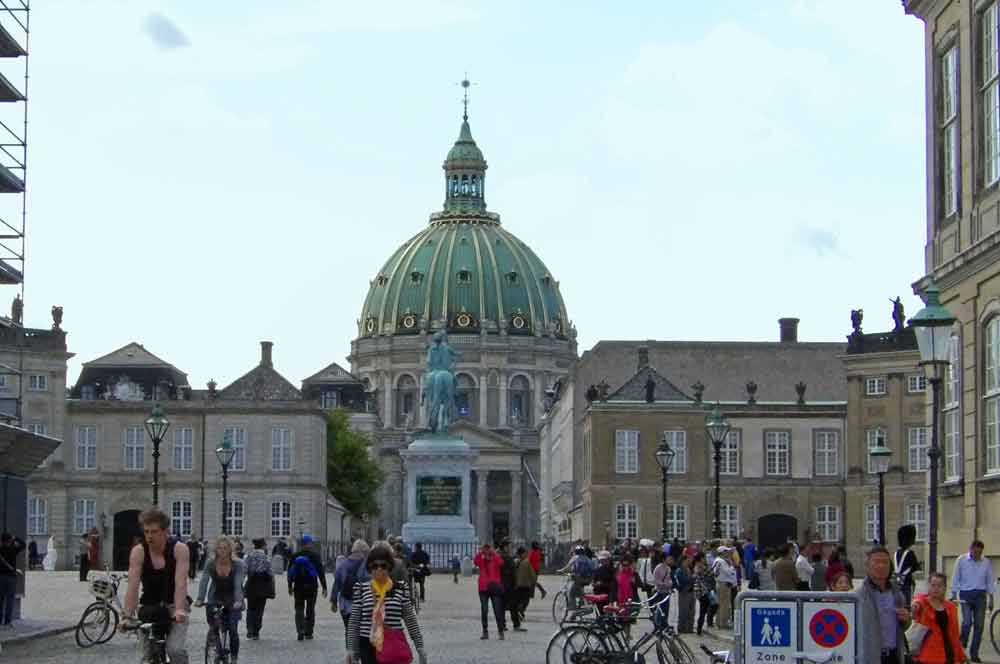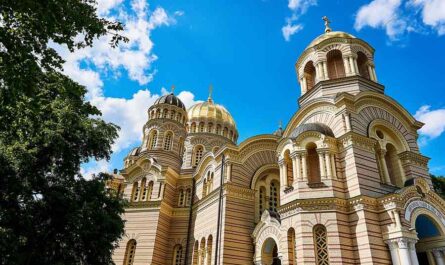Denmark is a promising European country with so much potential, history, and achievements. Denmark, a Scandinavian country in Northern Europe, boasts a rich tapestry of nature, culture, and history. Its captivating landscapes feature rolling hills, picturesque coastlines, and lush forests. The native Danish people, known for their friendliness and hospitality, contribute to the nation’s welcoming atmosphere. Geographically, Denmark consists of the Jutland Peninsula and numerous islands, including Zealand, Funen, and Bornholm. In this article, I am going to share some of the interesting facts about Denmark.
Interesting Facts about Denmark: Food, Culture, Travel
Customs and traditions are deeply rooted in Danish culture. Celebrations such as Midsummer’s Eve and Christmas are marked by festive gatherings, while the national flag, the Dannebrog, holds great significance and is proudly displayed on special occasions. The predominant religion in Denmark is Evangelical Lutheran Christianity, with the Church of Denmark being the largest religious institution. However, the country embraces religious diversity, with a growing Muslim population and various other faiths. Here are some interesting facts about Denmark:
1. Danish Lifestyle: A Harmonious Blend of Nature and Urban Elegance
Nestled within the heart of Denmark is a lifestyle deeply intertwined with nature, an ode to the great outdoors. The Danes, renowned for their love affair with cycling, seamlessly blend modern urban living with a profound appreciation for the environment. Picture a landscape where cities are not just concrete jungles but are adorned with lush green spaces, meticulously planned urban layouts, and a highly efficient public transportation system. The Danish lifestyle is a vibrant tapestry woven with threads of sustainable living, a commitment to preserving nature, and a passion for embracing the outdoors.
2. Historical Tapestry: Denmark’s Enduring Journey Through Time
Denmark’s historical narrative unfolds like a captivating tale, leaving an indelible mark on the European stage. From the tumultuous Viking Age to the resplendent Renaissance, Denmark has been a key protagonist in the theater of European history. The echoes of the past resonate through well-preserved historic sites and museums, each stone and artifact narrating a story of triumphs, challenges, and cultural evolution. The history of Denmark is a testament to the nation’s resilience and its enduring impact on shaping the contours of European civilization.
3. Customs and Traditions: The Rhythmic Heartbeat of Danish Culture
In the kaleidoscope of Danish culture, customs, and traditions emerge as the vibrant hues that define the nation’s identity. Moments of celebration, such as Midsummer, Christmas, and New Year, are not merely dates on the calendar but are woven into the very fabric of Danish life. Festive gatherings come alive with the laughter of families and friends, adorned with the rich tapestry of traditional rituals that have withstood the test of time. Danish culture is an intricate dance, where each step is guided by the rhythmic heartbeat of cherished customs and time-honored traditions.
4. Threads of Tradition: The Elegant Simplicity of Danish Attire
In the realm of fashion, the traditional Danish dress is a testament to the nation’s unwavering commitment to functionality and simplicity. While everyday attire reflects a practical approach to modern living, traditional costumes still grace special occasions and festivals. Picture the elegant simplicity of these garments, a harmonious blend of history and contemporary flair. The threads of tradition are intricately woven into the fabric of Danish attire, creating a visual narrative that bridges the past and the present.
5. Denmark’s Wintry Charm
Denmark, ensconced in a picturesque tapestry of snow and moisture, stands as a captivating Nordic nation, capturing the essence of a winter wonderland. The crystalline beauty of snow blankets the landscape, creating a serene ambiance that defines Denmark’s allure. This meteorological facet is but one facet among the myriad Denmark facts that contribute to the nation’s unique identity.
6. Coffee Connoisseurs of Scandinavia
In the caffeinated realm, Scandinavians, particularly the Danes, emerge as global frontrunners, boasting the highest per-capita consumption of espresso worldwide. The Danish populace, fueled by their fervor for this aromatic elixir, finds themselves ranking third globally, trailing behind the avid coffee enthusiasts of Sweden and Finland. A staggering average of four cups daily cements Denmark’s prominent status in the world of coffee connoisseurship.
7. Greenland: Icy Dominion
Greenland, an expansive territory under Denmark’s dominion, unfurls as the world’s largest island, an icy behemoth in the northern hemisphere. Surpassing Australia’s landmass, Greenland sprawls across a colossal 840,000 square miles (2,175,600 square kilometers). A staggering revelation lies beneath the icy surface, where an imposing ice sheet, measuring up to an astonishing 2 miles (3 kilometers) in thickness, envelops approximately 80% of Greenland’s expanse. Since the year 1953, this glacial dominion has been officially incorporated into the territorial folds of the Kingdom of Denmark.
8. Denmark’s Integrity: A Beacon of Transparency
Denmark stands as an exemplar of ethical governance on the global stage, earning the esteemed title of the “least corrupt” nation on Earth. This distinction showcases Denmark’s commitment to transparency, accountability, and ethical conduct in governance. The absence of corruption becomes a pivotal pillar in Denmark’s societal fabric, underlining its reputation as a beacon of integrity in a world often marred by ethical quandaries. This facet, while not a source of disturbance, resonates as a testament to Denmark’s unwavering dedication to ethical governance.
18. Scandinavian Exploration and Viking Legacy
Nestled in the captivating tapestry of Nordic history, countries such as Denmark, Sweden, and Norway are often revered for their Viking heritage, characterized by intrepid seafaring explorations across vast oceans. The echoes of the Scandinavian explorers, known as Vikings, resonate through time, leaving an indelible mark on the collective consciousness of these nations. Their maritime adventures, fraught with both peril and discovery, have become emblematic of a bygone era when the Northmen roved the seas in pursuit of new horizons.
19. Harmonious Anthem: ‘There is a Lovely Country’
Within the cultural tapestry of Denmark, the strains of national identity find expression in the melodic notes of “There is a Lovely Country,” the national anthem. This musical ode serves as a poignant reminder of Denmark’s rich history, cultural heritage, and the indomitable spirit that defines the nation. The anthem, a symphony of patriotism, encapsulates the beauty of Denmark’s landscapes and the resilience of its people, creating an auditory canvas that evokes a profound sense of national pride.
20. Greenland: Denmark’s Autonomous Territory
As the globe spins on its axis, Denmark extends its reach to the icy expanses of Greenland, an autonomous territory under its sovereign umbrella. This vast landmass, characterized by majestic glaciers and untamed wilderness, stands as a testament to Denmark’s geopolitical presence beyond its mainland. Greenland, with its stunning landscapes and unique indigenous cultures, contributes to the diverse narrative of Denmark, underscoring the nation’s role on both the European and Arctic stages.
21. Unveiling Danish Facts: The Patronymic Tradition
Beneath the surface of Danish nomenclature lies a fascinating tradition— the creation of surnames through the patronymic custom. This practice, rooted in the familial ties that bind generations, involves the formation of last names based on the father’s first name. Delving into the intricacies of Danish genealogy unveils a mosaic of surnames that not only serve as identifiers but also bear witness to the historical and familial connections that have shaped Denmark’s societal fabric. In this nuanced naming convention, the echoes of the past resonate, creating a living testament to the enduring legacy of Danish identity.
21. Denmark’s Constitutional Monarchy: A Legacy of Unbroken Leadership
Denmark, nestled in the heart of Europe, proudly boasts a constitutional monarchy, a political structure that has endured through the annals of time. The country’s leadership lineage stands as one of the most unbroken successions in the continent’s history. This enduring commitment to a constitutional monarchy has played a pivotal role in shaping the nation’s political landscape, fostering stability, and providing a sense of continuity that resonates through its rich cultural tapestry.
22. From Verdant Forests to Vanishing Timber: Denmark’s Changing Landscape
In a bygone era, Denmark was blanketed by vast expanses of lush forests and towering timber. However, the relentless march of progress and human intervention have left an indelible mark on the landscape. Much of the once-thriving woodland has succumbed to the saw and axe, as deforestation and modernization altered the face of the nation. This transformation underscores the delicate balance between development and environmental preservation that Denmark grapples with in the 21st century.
23. The Diverse Terrain of Denmark: More Than Meets the Eye
While Denmark is predominantly characterized by its gently undulating plains, there is more to its topography than meets the eye. Beyond the expanses of flat land, the nation embraces a captivating contrast—a rolling hill, a testament to the geological forces that shaped it during the ice age. The sinuous contours of this terrain serve as a reminder of Denmark’s dynamic past and the ever-evolving forces of nature that have left an imprint on its picturesque landscapes.
24. Football Fervor in Denmark
In the vibrant tapestry of Danish culture, football stands as a prominent thread, weaving its way into the very essence of the nation. Renowned globally for their passion for the sport, Denmark has not merely adopted football; they have embraced it as their national sport. The significance of football in the Danish psyche extends beyond the boundaries of a mere pastime; it is a cultural phenomenon that unites communities and stirs the hearts of the people. The roar of the crowd in a football stadium is not just a cacophony of sounds; it is a collective heartbeat, resonating with the fervor that defines Denmark.
25. Maritime Majesty: Denmark’s Coastal Charm
Denmark, a country embraced by the gentle caress of the Baltic and North Seas, is a geographical masterpiece where no corner is distant from the soothing embrace of the ocean. A mesmerizing fact about Denmark lies in its unparalleled proximity to the coastlines, as no point within the nation’s borders exceeds a mere 30 miles (50 km) from the ocean. This geographic feature not only shapes the climate and landscapes but also molds the identity of the Danish people. The omnipresence of the ocean in Denmark’s daily life is a testament to the profound connection between the land and its maritime surroundings, accentuating the nation’s coastal charm.
26. Etymological Odyssey: The Origins of Denmark
Delving into the etymology of Denmark unveils a captivating linguistic odyssey that dates back to the annals of history. The very name “Denmark” is believed to derive its meaning from the Old Norse term “Danmǫrk,” which translates to the “Land of the Danes.” The historical roots of this nomenclature trace back to approximately A.D. 900, as documented in King Alfred the Great of England’s translation of Orosius’ Geography. The mention of Denmark in this ancient text echoes through time, encapsulating the essence of a nation whose name is intertwined with the proud legacy of the Danes, transcending centuries and cultural transformations.
27. A Diverse Sporting Landscape
Contrary to the common misconception that Denmark solely revolves around soccer, the country boasts a diverse sporting landscape that extends well beyond the confines of a football field. While football may hold the title of the national sport, Denmark’s sporting enthusiasts indulge in a myriad of athletic pursuits. From handball and cycling to sailing and badminton, the Danish people revel in the diversity of sports, fostering a well-rounded and dynamic sporting culture. This multifaceted approach to athletics highlights Denmark’s commitment to embracing a wide spectrum of physical activities, contributing to the holistic development of its populace.
28. Social Welfare in Denmark: Education and Healthcare as Fundamental Rights
Denmark stands as a paragon of social responsibility, where the welfare of its citizens takes center stage. Danish nationals are bestowed with a priceless privilege: free access to education and healthcare. This means that the government assumes the mantle of caretaker for the basic needs of its populace, ensuring that every individual has an equal opportunity to education and is safeguarded by a robust healthcare system. The embodiment of a socially conscious state, Denmark’s commitment to its people’s well-being is a testament to the nation’s progressive ideals and egalitarian ethos.
29. Swimming Culture in Denmark
In the picturesque land of Denmark, a nation woven with a rich tapestry of tradition and lifestyle, a notable aspect ingrained in the very fabric of society is the art of swimming. Virtually every Dane, from the bustling cityscape of Copenhagen to the quaint villages nestled by the North Sea, is equipped with the essential skill of swimming. This proficiency is not merely a personal choice but an integral part of the educational tapestry. It is noteworthy that swimming classes stand as a mandatory component of the curriculum in every state-run educational institution across the Danish landscape. The cultural emphasis on aquatic prowess not only ensures a population adept at navigating water but also reflects the nation’s commitment to holistic education.

30. Soccer Glory and National Pride
Denmark, a nation steeped in a rich cultural tapestry, holds soccer as its paramount passion and national pride. The zenith of the Danish soccer narrative unfolded on the global stage during the 1986 World Cup, where the national team etched its name into the annals of sporting history with a performance that resonated globally. This indomitable spirit endured, culminating in their crowning as the European champions in 1992, solidifying Denmark’s imprint on the international soccer arena. The resounding echoes of their triumphs continue to resonate, binding the nation together through the collective joy of soccer achievement.
31. The British Love Affair with Danish Bacon
The culinary landscape of England bears testament to a profound love affair with Danish bacon, a relationship dating back to 1867. The English, renowned for their discerning palates, wholeheartedly embraced the savory allure imported from Denmark. A gustatory sensation, Danish bacon became an integral part of English breakfasts, weaving its way into the fabric of the nation’s gastronomic heritage. This gastronomic liaison not only fueled the nation but also symbolized the enduring cultural exchanges that have defined the relationship between Denmark and England for over a century.
32. Whispers of the Wind in Denmark
Denmark, with its picturesque landscapes, is often characterized by the gentle caress of the wind. The meteorological symphony that graces the country manifests in an average wind velocity of 13 miles per hour (5.8 m/sec). However, the climatic narrative took a dramatic turn as Hurricane Allan made landfall on October 28, 2013. In a tempestuous display of nature’s fury, record-breaking wind speeds of 88 miles per hour (142 km/h) and gusts reaching a staggering 119 miles per hour (193 km/h) were etched into the meteorological chronicles, leaving an indelible mark on Denmark’s climatic saga.
33. Crime Waves in the Danish Landscape
Beneath the idyllic façade of Denmark lies a societal canvas marked by the shadows of crime. Statistics reveal a sobering reality: one-fifth of Danish households grapple with the specter of crime each year. A disconcerting surge unfolds as reported crimes surge, more than tripling over the last three decades to surpass half a million incidents annually. The unsettling crescendo encompasses various realms of criminality, with violent crime, break-ins, and petty theft carving disconcerting niches within the societal fabric. Denmark, in its paradoxical juxtaposition, grapples with the complexities of maintaining its societal harmony amidst the rising tide of criminal challenges.
34. Knud Rasmussen: The Arctic Odyssey of a Danish Explorer
In the frigid expanse of the Arctic, Danish explorer and anthropologist Knud Rasmussen etched his name in the icy winds of history. The indomitable spirit of exploration led Rasmussen to a pioneering feat—the first European to traverse the formidable Northwest Passage astride a dog sled. Against the backdrop of ice and solitude, Rasmussen’s accomplishment resonates as a testament to human resilience and the relentless pursuit of knowledge. Venturing where many feared to tread, he became a trailblazer in the unforgiving Arctic terrain, weaving a narrative that transcends borders. Rasmussen’s achievement not only exemplifies the adventurous spirit of Denmark but also cements his legacy as a polar explorer whose daring exploits resonate through the corridors of time.
35. Denmark’s Remarkable Income Equality
Denmark stands out on the global stage due to its exceptional level of income equality, distinguishing it as a nation that prioritizes socioeconomic balance. This Nordic country has successfully cultivated an environment where the distribution of wealth is notably fair, fostering a society where economic disparities are minimized. The commitment to high-income equality contributes significantly to the nation’s overall societal harmony and progressive ethos. This unique attribute sets Denmark apart and positions it as a model for nations seeking to address income disparities and promote social cohesion.
36. Literary Excellence: Denmark’s 99% Literacy Rate
One of Denmark’s crowning achievements lies in its commitment to education, as reflected in an impressive literacy rate of 99%. This statistic underscores the nation’s dedication to fostering a highly educated and informed citizenry. The Danish emphasis on literacy serves as a testament to their belief in the transformative power of education. With a near-universal ability to read and write, Denmark not only ensures the intellectual empowerment of its population but also lays the foundation for a society that values knowledge, critical thinking, and cultural enrichment.
37. Copenhagen: Denmark’s Pulsating Capital
Nestled at the heart of Denmark, Copenhagen stands as the nation’s vibrant and bustling capital, radiating cultural richness and historical significance. Boasting a captivating blend of medieval charm and modern sophistication, Copenhagen beckons visitors with its picturesque landscapes and architectural marvels. As the largest city in Denmark, Copenhagen pulsates with life, offering a dynamic tapestry of art, cuisine, and entertainment. Its status as the epicenter of Danish culture makes it a must-visit destination for those seeking a harmonious fusion of tradition and contemporary allure.
38. Søren Kierkegaard: The Father of Existentialism
The profound intellectual landscape of the 19th century found its cornerstone in the musings of the Danish philosopher, Søren Kierkegaard. Revered as the unequivocal “Father of Existentialism,” Kierkegaard reshaped the contours of philosophical thought by encapsulating human existence through the prisms of ethics, aesthetics, and faith. His philosophical opus not only penetrated the intellectual spheres of his time but continues to resonate across the corridors of philosophical inquiry, leaving an indelible mark on the way we contemplate the human experience.
39. The Virgin Islands: An American Acquisition from Denmark
In the annals of geopolitical transactions, the United States made a significant stride in 1917 by acquiring the Virgin Islands, a West Indies gem, from Denmark. This transaction, shrouded in historical nuance, added a chapter to the complex narrative of colonial possessions and territorial expansions. The assimilation of the Virgin Islands into the American fold bears witness to the intricate tapestry of international relations, where geopolitical chess moves carve the contours of nations.
40. Walt Disney’s Danish Inspiration: Tivoli Gardens and Disneyland
In the kaleidoscope of cultural exchanges and creative inspirations, Walt Disney’s visit to Tivoli Gardens in Copenhagen stands as a pivotal moment. Enthralled and captivated by the enchanting allure of this Danish amusement park, Disney harbored a vision to transplant its magic to American soil. Thus, Disneyland, an embodiment of whimsy and fantasy, sprouted from the seeds sown in the fertile grounds of Tivoli Gardens. This intercontinental creative symbiosis highlights the power of cross-cultural influence in shaping entertainment phenomena. Fitness – Meditation – Diet – Weight Loss – Healthy Living – Yoga
41. Royal Copenhagen Flora Danica: A Botanical Tapestry Fit for Royalty
In the delicate dance of diplomatic gifting, the Royal Copenhagen Flora Danica dinner service emerges as a masterpiece that transcends mere tableware. Commissioned in 1790 by King Christian VII, this opulent creation was destined for Tsarina Catherine II, known as Catherine the Great, of Russia. Adorned with meticulously crafted floral designs extracted from the Flora Danica Encyclopedia, this dinner service is not just a vessel for culinary delights but a botanical tapestry, a regal token intertwining the realms of horticulture and diplomacy. The legacy of this extravagant gesture echoes through the corridors of time, epitomizing the fusion of artistic finesse and regal diplomacy.
42. The Significance of Copenhagen: Denmark’s Urban Jewel
Delving deeper into the essence of Copenhagen, it becomes evident that this metropolis holds paramount importance in the Danish narrative. Not merely a geographical center, Copenhagen embodies the spirit of innovation and cultural evolution. The cityscape is adorned with landmarks that narrate tales of Denmark’s historical journey, seamlessly blending the old with the new. From the iconic Little Mermaid statue to the splendid Tivoli Gardens, Copenhagen encapsulates the nation’s ethos, making it a living testament to Denmark’s commitment to preserving its heritage while embracing progress.
More Interesting Articles




